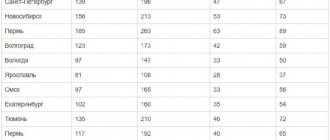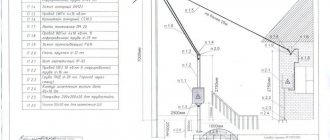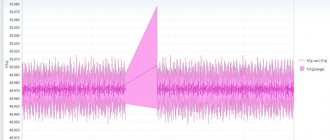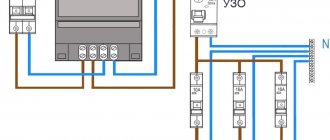Housing and communal services
Mikhail Bondarev Author of the article
9
Everywhere we use light and household appliances and cannot imagine life without electricity. In the modern world, this housing and communal service is perhaps one of the most in demand. The government has established standards for electricity consumption per person, and they are constantly increasing. Thus, the state encourages citizens to install metering devices, which ultimately save resource consumption.
For those houses or apartments that are not equipped with individual electricity meters, consumption is calculated based on the standard per resident and the cost of the tariff per 1 kilowatt-hour.
The rate of electrical energy consumption is set by regional authorities.
Social norm for electricity consumption
First, it’s worth understanding the very essence of the social norm for electricity consumption.
Government Decree No. 614 of 2013 covers this topic in detail. To briefly explain the essence of the issue, we can highlight the following features:
- The law defines the minimum amount of monthly energy consumption. Due to this, the basic needs of the apartment residents are satisfied.
- The price for this volume is slightly lower compared to the parameter in force before the introduction of the norm. If the volume is exceeded, the cost increases.
The state is striving to create an additional incentive to save electricity. And those who increase consumption are forced to pay more, at the same level as representatives of the small commercial sector.
Complexity and confusion are the main problems when implementing an idea.
Average consumption data for household electrical appliances
In order to have an idea of whether it is possible to “fit” into the social norm, you need to know how much electricity is “used” to use a particular household electrical appliance.
| Name of household electrical appliance | Electricity consumption, kW/hour |
| Fridge | 30-40 |
| Computer | 30 and above |
| TV | from 7.5 |
| Washing machine | 25 and above |
| Vacuum cleaner | 4 |
| Iron | 15 |
| Hairdryer | 12,5 |
| Electric kettle | 10 |
| Room lighting | 90 |
| Dishwasher | 24 |
| Microwave | 5 |
What can you do to reduce costs?
The first step is to replace conventional incandescent light bulbs with energy-saving options.
When choosing household appliances, you also need to take a closer look at the class of electrical energy consumption. A or A+++ are the most economical options. It is not recommended to turn on air conditioners with open windows. Then heating and cooling the rooms takes longer. This means that electricity consumption is also higher.
The temperature inside and outside should not differ too much from each other. The best installation location for cooling devices is where the sun's rays and heat practically do not reach them.
If an electric kettle is working, it is better to remove scale from it in a timely manner. Otherwise, the water takes longer to heat up and more resources are consumed.
Social norm for electricity: how it is calculated
To solve the problem use the formula:
S = K x N x T
- T – standard tariff for 1 kW/hour.
- N is the consumption rate for a specific region.
- K is the number of residents registered at this address.
- S – total payment amount.
A different tariff applies to citizens living in private houses. It is especially worth highlighting buildings where metering devices are not installed. In this case, the main factor is the number of people who registered.
Compliance with regulations should not be a problem. But it is necessary to limit the use of equipment with high consumption rates.
How much do they pay for electricity without a meter?
Everyone decides for themselves whether to pay according to the meter or according to the standards. According to the standards, it is more profitable to pay if there are many more people living in a residential building than are registered. In addition to the number of registered ones, the following is taken into account:
- number of rooms;
- presence of an electric stove;
- urban or rural;
- total area.
The most common coefficient for calculation is 1.5. This is due to an increase in total power due to an increase in the number of electrical appliances in the premises. When calculating the amount for electricity, it is necessary to multiply the standard by the number of residents, by the tariff and by the increasing factor.
Example. A family of three lives in a one-room apartment in Moscow. They pay according to the standard because the meter is broken. The stove in the house is gas. Amounts for electricity per month = 45x3x5.47x1.5 = 1107 rubles. If the same family connects electricity, bypassing the meter, the amount will increase 10 times, instead of one and a half, and will be 7,384 rubles.
In order not to pay the increasing factor, you need a certificate stating that the meter cannot be installed for technical reasons or the house is recognized as unsafe. In this case, the same family will pay the amount without an increasing factor, which is 738 rubles.
For residents of rural areas, when calculating, 90 kWh per person is added to the standard. When calculating electricity consumption, the standard per person is taken . For Moscow, the payment is 45x5.47 and equals 246 rubles.
For a rural region, in addition to the standards, the calculation of electricity that the homeowner spends on lighting outbuildings and keeping farm animals is added.
For example, one person lives in a rural house. He has a gas stove, a 4-square-meter barn that is separately lit, and he has a cow. In this case, the electricity consumption standards for the same Moscow region will be calculated as follows: (5.47x14x4+(45+0.83)x5.47)x 1.5= 834 rubles.
This formula is based on the following calculation indicators:
- When lighting outbuildings, 14 kWh per month is added to the standard for each square meter of premises, unless a separate meter is installed for them.
- For keeping animals, the norms are calculated for each head per month: for cows - 0.83, for pigs - 0.83, and for birds 0.33 kW/hour. All other animals – 0.17 kW/hour.
The amount turns out to be impressive, which is why most citizens voluntarily install meters . It is especially beneficial to purchase metering devices for those who have more people registered in their house than actually live there. The presence of centralized hot water supply is also taken into account.
In apartment buildings where there is none, electric boilers are widely used. This leads to an increase in the standard, since electricity costs in such apartments are always higher (what is the average electricity consumption in an apartment per month?).
With missing devices
Here they rely only on current consumption standards for 1 person. Since 2015, increasing coefficients have been introduced. Especially in situations where there is a technical opportunity to install meters, but they decided not to use it. The presence of such a possibility also affects the application of tariffs.
In this case, the consumer must submit a special report confirming the absence or presence of technical restrictions for installing the device.
Utility service providers issue a separate warning that if errors are not corrected, certain increase factors will apply. The right to apply coefficients appears if a warning is issued, but within two months the other party has not taken any action to eliminate the problem.
How is the electricity utility consumption standard regulated?
The standard for electricity consumption is set separately for each region of the Russian Federation. This figure is regulated by local governments. Legislative framework for consumption standards:
- Federal Law No. 190 “On Heat Supply”.
- Federal Law No. 614 “On the procedure for establishing and applying social norms for electricity consumption.”
- Federal Law No. 261 “On Electricity Supply”.
- Order of the Government of the Russian Federation No. 1650-r.
It is on these legislative acts that all other documents on standards that are adopted in the constituent entities of the Russian Federation are based. There is only one important rule: the standard established by the region cannot differ from the federal standard by more than 40%.
It is more profitable for the authorities for the population to install metering devices, and therefore for those who are calculated according to the standards, an increasing coefficient has been established. In most cases, paying for light according to the standards becomes unprofitable.
Features of recalculations
Recalculation of fees in connection with social norms is an issue that deserves separate consideration. When such rules are applied, some categories of citizens gain access to additional benefits. This usually applies to pensioners, large families, and so on. The following rules are introduced for them:
- For the first year, the entire amount of energy consumed is paid within the current norm.
- In the future, the fee increases by 1.5 times.
The consumer can submit a written application himself if there is a right to a benefit, but until now it has not been possible to use it. The recount must be carried out no later than 10 days after receipt of all documents.
Recalculation is also carried out if the category of consumer changes for one reason or another.
The same rules apply to households, regardless of category. But it is important to pay attention to registering citizens or deregistering them at a particular address.
Consumers are required to notify utility providers of changes in the composition of such households. Otherwise, the use of the benefit is considered illegal if there are no grounds for it. Recalculations are carried out for no more than three previous months.
Registration authorities also transmit information related to the number of residents. Performers carry out recalculation if certain information turns out to be unfounded. The period is standard - no more than the previous three months.
How much is the standard for 1 person in 2022?
This is a purely regional figure that differs depending on several factors. If we consider the largest cities of the Russian Federation, then for 2022 the indicators are as follows:
| City | One person living with a gas stove | One resident with an electric stove | Family with gas stove | Family with electric stove |
| Moscow | 50 | 80 | 45 | 70 |
| St. Petersburg | 78 | 111 | 48 | 63 |
| Chelyabinsk | 100 | 180 | 90 | 130 |
| Rostov | 113 | 182 | 82 | 90 |
| Vladimir | 100 | 190 | 75 | 130 |
| Krasnodar | 97 | 147 | 60 | 95 |
| Ekaterinburg | 102 | 160 | 63 | 100 |
In addition, there is a coefficient that differs depending on the reason for calculating tariffs according to the standard. The largest coefficient is if the meter is deliberately broken or the electricity is connected in such a way that it bypasses the meter.
Without an increased coefficient, only small categories of citizens who have a good reason not to install a meter or are unable to transfer data from it can pay.
Settlements with RSO
Separate accounting of the energy supplied to each of the operating households is carried out. Such volumes are indicated separately when purchasing resources. The parties are obliged to exchange any information provided for in current legislation. The main thing is that the price of resources is calculated taking into account current tariffs.
Video about how much electricity household appliances consume:
See also Phone numbers for consultation Oct 25, 2022 Victoria M. 1025
Share this post
Discussion: there is 1 comment
- Valentina says:
01/11/2020 at 20:59Mom is a labor veteran, and she is provided with electricity benefits exactly from the norm, that is, they pay compensation from the amount that she would have paid according to the norm, but she pays less than the norm according to the meter. This results in good savings, so the standards are already being applied in some cases. Regarding the fact that expenses above the norm are paid at a more expensive rate, I think it is correct. We need to save, and maybe in this way people will become more thrifty.
Answer
In what cases is the average tariff calculated?
It is necessary to pay for electricity using standard indicators in the following cases:
- the individual electric energy meter is broken, out of order or was never installed;
- an employee of a company responsible for accounting for electricity costs did not have free access to the metering device;
- intentional damage to the device;
- information from the meter was transmitted late;
- metering node not found.
If there is a meter, then you need to transmit its readings on time so that you do not have to pay according to the standard. It is necessary to transfer the readings either to the energy sales company, which is the supplier of electricity, to the management organization, or to the city settlement center. Payment according to the standard begins from the 4th month of data absence.
If data was previously transferred, then payment is made based on average monthly consumption based on previously transferred indicators. If the meter breaks down, it is necessary to establish when it happened. This could be a fire, meter theft, mechanical failure, or technical problems.
If the exact date cannot be established, then they will count from the month when the meter was broken. In this case, the user is initially transferred to pay at the average monthly rate, based on previously provided data for the last six months. After 3 months, if the meter is not restored, payment according to the standard will apply.
If during inspection of the metering device unauthorized intervention was detected, a special report is drawn up. There are several signs that the device is broken intentionally. They must be indicated when drawing up the Act. Based on this document and from the date of its preparation, electricity is recalculated to the standard, which is increased by 10 times.
The recalculation is made for the last 3 months that preceded the drawing up of the act . At this rate, the user will pay until the violations are eliminated. Most often this happens when the meter is replaced. As for preventing utility company employees from accessing the meter, there is a certain procedure.
If during working hours it is not possible to get to the metering device, the employee is obliged to send a notification and coordinate his visit with the owner of the apartment. If after two notifications it is not possible to get to the meter, or after approval the owners cannot be found at home at the specified time, a report is drawn up.
From this date, the consumer is transferred first to the average monthly payment, and then to the consumption standard. Therefore, it is in the interests of homeowners to allow a utility worker to access the metering device so that they do not have to pay according to the standards, and even with an increased coefficient.
In the case where the meter has not been installed and no one is officially registered in the apartment, the standard will be calculated based on the number of owners of the residential premises.











